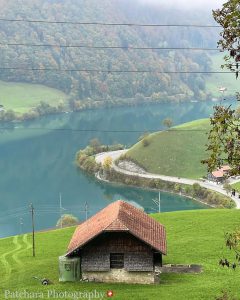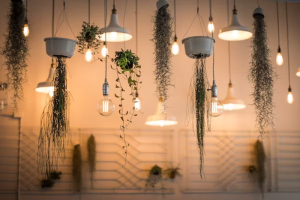J Lyons and Co. Ltd
v
Attorney-General
Supreme Court
1994
A company tried to treat lighting in a tea shop as a plant.
As mentioned in Yarmouth v France– the beginnings of a definition above, the earliest definition of the plant came from a case that had nothing to do with tax.
Given the significance that the term has developed for tax purposes, there is a small irony in the fact that the next stage in the development of the definition was again in a non-tax case, this time under the War Damage Act 1943.
The case in question was that of J. Lyons & Co Ltd v Attorney General.

The War Damage (Amendment) Act of 1943 gave compensation for damage to land and defined land as including buildings or plant.
In this case, the company claimed that some lamps that were destroyed by enemy action were plant and so qualified for compensation under the War Damage Act.
The lamps were not part of the building, and the question was, therefore:
- whether or not they were plant?
The facts and issues are summarised in the headnote to the case as follows:
‘A tea-shop having been damaged by enemy action in 1941, the company owning it claimed a cost-of-works payment … which included the cost of replacing electric lamps used for lighting the premises, and fittings annexed thereto, as being “plant” or “machinery” …
Held, that the electric lamps and fittings were not part of the apparatus used for carrying on the business but were part of the setting in which the business was carried on and, therefore, were not “plant”, the subject of compensation within the Act.’
As the key issue to arise is the distinction between setting on the one hand and plant on the other, it is worth looking at the judge’s reasoning.

‘In the present case, the question at issue may, I think, be put thus: Are the lamps and fitments properly to be regarded
- as part of the setting in which the business is carried on; or
- as part of the apparatus used for carrying on the business?
The lamps and their fitments are owned by a caterer and used in premises exclusively devoted to catering purposes. Still, the presence of lamps in this building is not dictated by the nature of the particular trade there carried on or by the fact that it is for trade purposes that the building is used.
Lamps are required to enable the building to be used where natural light is insufficient.
The actual lamps themselves, so far as the evidence goes, present no special feature either in construction, purpose or position, and, being supplied with electricity from public suppliers, they form no part of an electric lighting plant in or on the hereditament.
In my opinion, these lamps are not, in these circumstances, properly described as “plant” but are part of the general setting in which the business is carried on.
They would not, I think, in any catalogue of this trader’s assets, fall under the heading “machinery and plant”, and I hold that the lamps and the fitments in question are not machinery or plant for the purposes of the War Damage Act 1943.’
The key point to draw out of this ruling is probably the comment that the lamps presented ‘no special feature either in construction, purpose or position’.
Any such special feature would perhaps have swayed the opinion – the lamps would perhaps no longer have been perceived as ‘part of the general setting’ but rather as some trade-specific apparatus brought into that setting.

So, how has this apparatus-versus-setting distinction survived more than half a century of case decisions?
As with all other aspects of the definition of plant, the picture is unclear. Certainly, the principle has survived and has received judicial approval repeatedly.
For example, in the Cole Brothers case, Oliver LJ reworked the same formula when he commented as follows:
‘At risk of propounding yet a further refinement, it seems to me that the authorities, with one possible exception, demonstrate that the question (however expressed) which the court must ask itself is whether the particular subject matter under consideration either itself performs, or is a necessary or integral part of that which performs, simply and solely the function of “housing” the business or whether, as its sole function or as an additional function, it performs some other distinct business purpose.’

But the distinction is not always clear-cut. In Jarrold v Good, which concerned moveable partitions, the judge considered the reasoning of the J Lyons & Co case and questioned whether the contrast between apparatus on the one hand and setting on the other could always stand scrutiny:
‘I do not want to appear to doubt in any way the correctness of that decision on the facts of that case, but it seems to me that the setting in which a business is carried on, and the apparatus used for carrying on a business, are not always necessarily mutually exclusive.
Certain fixtures or chattels in certain trades may well represent the setting in which the business is carried on, from one point of view and the apparatus used for carrying on the business, from another point of view.
This point is, I think, the same or akin to that made by Uthwatt, J., when he mentioned that the lamps “present no special feature either in construction, purpose or position”.
In the present case, the trade is that of a shipping agent carried on in an office building in the manner set out in the Case Stated.
Concerning that trade, as so carried on, it seems to me that these partitions are, from one point of view, the setting in which the business is carried on, but from another point of view, the apparatus used for carrying on the business.
If one considers the staff engaged in the respective rooms formed by the partitions at any given moment, the partitions, like the floor and ceiling, are the setting in which the staff carry out their duties.

But if one considers the Company’s policy of office organisation as set out in the Case Stated, then the partitions are fixtures specially designed to enable an appropriate and the varying number of employees to perform their duties in an appropriate and the varying number of sections, according to the state of the Company’s business at the time.
It seems to me to be impossible to deny to fixtures possessing this character the title of apparatus used by the Company for carrying on its business.
Once this is accepted, the partitions clearly qualify for allowances as plant, notwithstanding that, from another point of view, they may be part of the setting.’

In other words, the judge was accepting the original Yarmouth v France reasoning (as the partitions were apparatus, they would ‘clearly qualify’ as a plant) but was limiting the application of the J Lyons & Co principle of contrasting plant with the setting.
This limitation was approved in the same case in the Court of Appeal, where Donovan LJ concluded that ‘you cannot always answer the question, “Is this plant?” by asking, “Is it part of the setting or not?”’
Is the distinction between apparatus and setting of any continuing value in deciding whether or not an item qualifies as a plant?
It is tempting to conclude that the courts are saying no more than that the distinction applies except when it does not apply.
The Leeds Permanent Building Society successfully went to court to establish that certain decorative screens in their windows were plant.
The judge in that case (Leeds Permanent Building Society v Proctor) commented as follows:

‘In applying that conception of the apparatus used by a businessman for carrying on his business, it was found convenient to distinguish the setting in which a business is carried on and the apparatus with which a business is carried on, though subsequent developments have shown that there are overlapping cases where the distinction is not in itself decisive because one object may partake of both characters.
Leaving those overlapping cases to one side, that which is the setting in which the trader performs his trade is not plant; the apparatus with which he performs it is plant.’
The conclusion would appear to be that an item:
- may be apparatus, or
- it may be setting, or
- it may be both.
For an inspector to show that it is not a plant, he must demonstrate that it is only the setting.
Even this argument cannot be pushed too far, however, as counsel for Wimpy International found.
The commissioners had disallowed the cost of shop fronts as a plant as ‘their principal function is to form a necessary part of the premises’.
A Mr Aaronson had argued that this showed that the commissioners had ‘misunderstood or misapplied’ the functional test.

‘Lloyd LJ in the Court of Appeal considered that argument as follows:
The question is not, he says, whether the principal function of the shop fronts is to keep out the weather, or whatever, but whether that is their sole function.
If the shop fronts have some other business function as well, for example, by capturing the passer-by’s attention or by allowing the already captive customer to see out … then the shop fronts qualify as plant …
I cannot accept that it is correct to subject the Commissioners’ decision to this sort of linguistic analysis.’
Nevertheless, the principle would seem to remain.
It should be remembered, however, that all the cases referred to in the above paragraphs predate the 1994 legislation, which restricts the definition of a plant.
For an item to qualify as a plant, it must satisfy two tests.
The prevailing orthodoxy was that firstly, it must be shown that the item in question does not fall foul of the legislation now in CAA 2001, s. 21 and 22.
And secondly, it must be demonstrated that on the case law principles discussed above, it is properly treated as apparatus.

Our website's articles, templates, and material are solely for reference. Although we make every effort to keep the information up to date and accurate, we make no representations or warranties of any kind, either express or implied, regarding the website or the information, articles, templates, or related graphics that are contained on the website in terms of its completeness, accuracy, reliability, suitability, or availability. Therefore, any reliance on such information is strictly at your own risk.
Keep in touch with us so that you can receive timely updates |
要获得即时更新,请与我们保持联系
1. Website ✍️ https://www.ccs-co.com/ 2. Telegram ✍️ http://bit.ly/YourAuditor 3. Facebook ✍
- https://www.facebook.com/YourHRAdvisory/?ref=pages_you_manage
- https://www.facebook.com/YourAuditor/?ref=pages_you_manage
4. Blog ✍ https://lnkd.in/e-Pu8_G 5. Google ✍ https://lnkd.in/ehZE6mxy
6. LinkedIn ✍ https://www.linkedin.com/company/74734209/admin/






